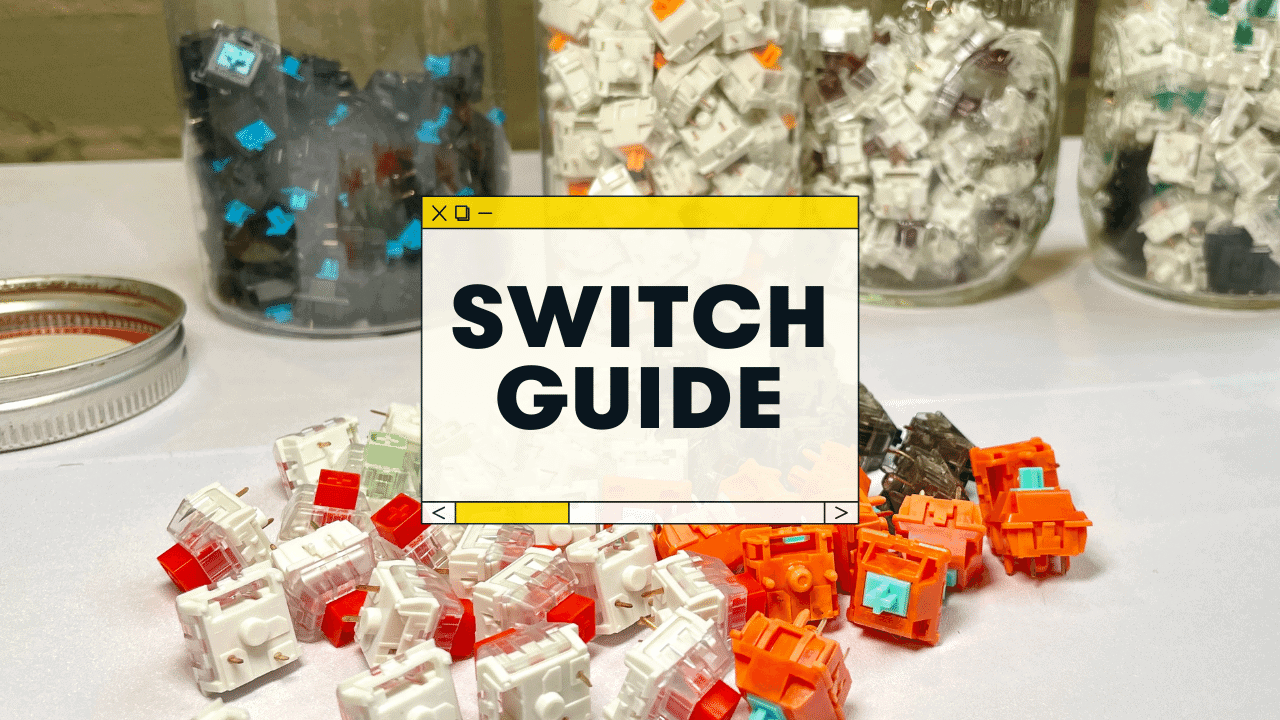Mechanical keyboards are becoming hugely popular for gamers and typists alike…
But there are a TON of color switches to choose from–and which one you choose will make a HUGE difference in the way your mechanical keyboard looks, feels, and sounds!
I’ve spent too much time (and money) playing around with keyboard switches, so I’m going to break down the different types of switches and colors for you.
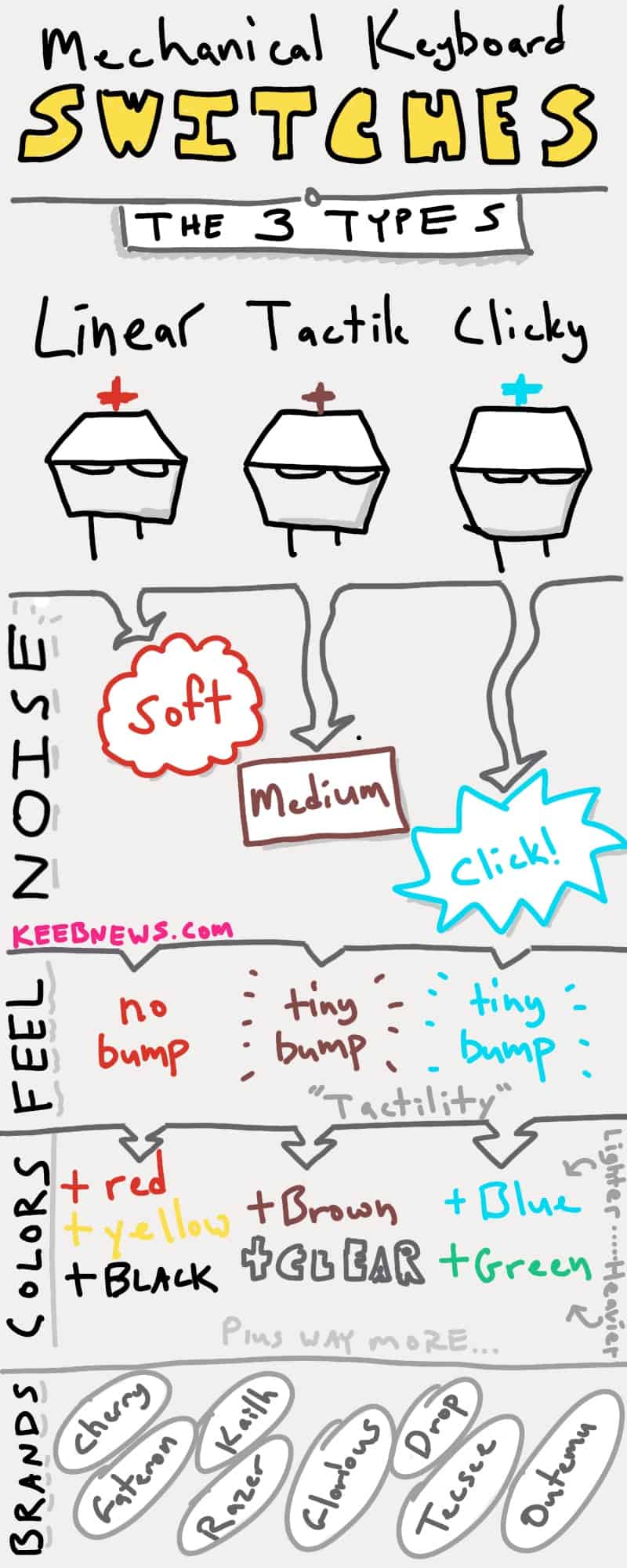
Anatomy of the Parts of a Mechanical Keyboard Switch:
Let’s break down a switch (from top to bottom, kinda):
- Keycaps (not actually part of the switch): The keycaps are the part of the switch that you actually touch. They’re usually made from ABS or PBT plastic, and come in tons of different colors & styles! (and shapes and profiles)
- Switch stem: This is the part of the switch that extends down into the switch and moves up and down when you press the keycap (it’s connected to the underside of the keycap). The stem is generally colored to match the switch color. I.e. green switches usually have green stems
- Upper housing: This is the part of the switch that contains the spring and rests on top of the lower housing. It has a hole in the center for the stem to fit into (the upper and bottom housings snap together, and you need a “switch opener” tool to take them apart. Or a flathead screwdriver, but that’s harder).
- Spring: This is what provides the resistance when you press a key down, and also gives it that “bouncing” feeling.
- Lower housing: The bottom half of the switch “shell” or “box.”

The bottom housing has metal contacts on the inside (called “leaves”).
The stem touches these (when pressed down), and that creates the electrical signal that tells your computer which key was pressed!
Common terms related to switches:
You’ll probably encounter some of the following words when buying switches, and it’s important to know what they mean!
- Actuation Type: This is whether a switch is linear (1), tactile (2), or clicky (3).
- Actuation Force: This is how much force is needed to activate a switch. It’s usually referred to in terms of grams. I.e. “55g actuation force”
- Actuation Distance: This is how far down the switch you need to press it before it activates. It’s usually measured in millimeters.
- Travel Distance (yes, it’s different): This is the total distance a key has to travel before it’s fully depressed. (called “bottoming out,” i.e. reaching the bottom). It’s usually measured in millimeters as well.
- Lifespan: This is how many millions of keystrokes a switch can withstand before it fails. Mechanical switches last a LONG time!
- “MX style” switches: “Cherry” is a name brand of switches, but “MX” just refers to the most popular type of switch popularized by Cherry (these are generally considered the gold standard). Cherry MX Browns and Gateron Browns are both MX-style switches.
The 3 General Types of Keyboard Switches
All switches fall under 3 broad categories:
- Linear: The simplest type. Pressing them is a straight, smooth path from the top to the bottom. There’s no tactile or auditory feedback when you press them, and they require the least amount of force to actuate.
- Tactile: These switches provide a tiny “bump” when you press them (generally around the actuation point). This “tactile feedback” helps your fingers feel when the key has actually been registered.
- Clicky: These are a sub-type of tactile switches. There’s the tiny bump, but with a small audible “click.” These are generally louder.
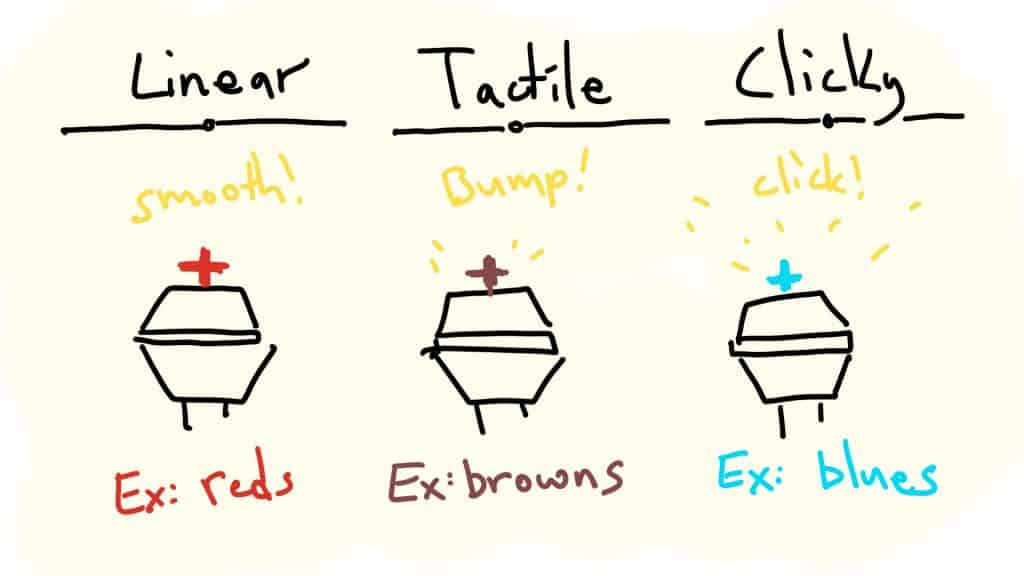
We’ll go over more below, but here are some popular colors for each type of switch:
| Switch Type | Common Colors | Feel | Noise Level | Used for |
|---|---|---|---|---|
| Linear | Red, Black, Yellow | Smooth, no bump | Soft to medium | Mostly gaming |
| Tactile | Brown, Clear | Has tiny bump | Medium | Gaming, Typing |
| Clicky | Blue, Green | Has tiny bump | Medium to loud | Gaming, Typing |
There are way more colors, but these are the basics.
(And if you see switches like the Akko Rose Reds, you can be reasonably sure those are linear switches. If you encounter Kailh Box Jades, you can probably assume that “jade” is similar enough to blue and green, and therefore it’s probably a clicky switch!)
Related posts 👇
- Click here to read more about how tactile switches work.
- The 5 Best Clicky Switches for Your Keyboard (2023)
- The 10 Best TACTILE switches (2023)
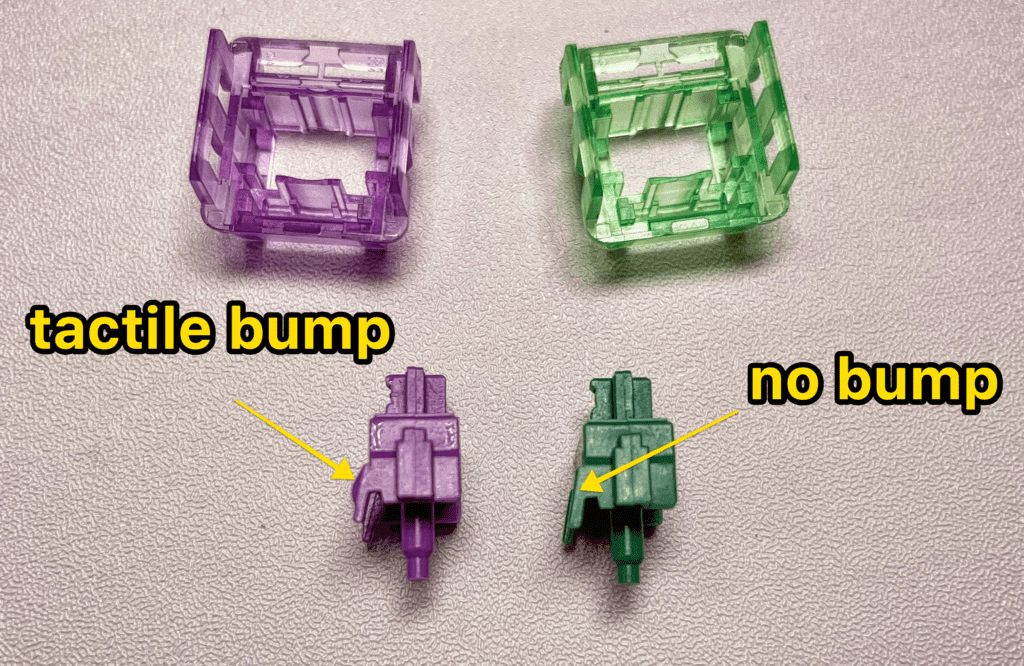
Silent, Low-Profile, and Speed Switches
There are also some specialty switches out there, all built for a specific purpose:
Silent switches:
These are switches that have been designed to be super quiet. They’re a good choice for people who want to minimize noise, or for use in offices (unless you ENJOY annoying your coworkers).
Silent switches are usually linear switches (because linears are usually software by nature), but you can do a bit of searching and come up with some silent tactiles as well.
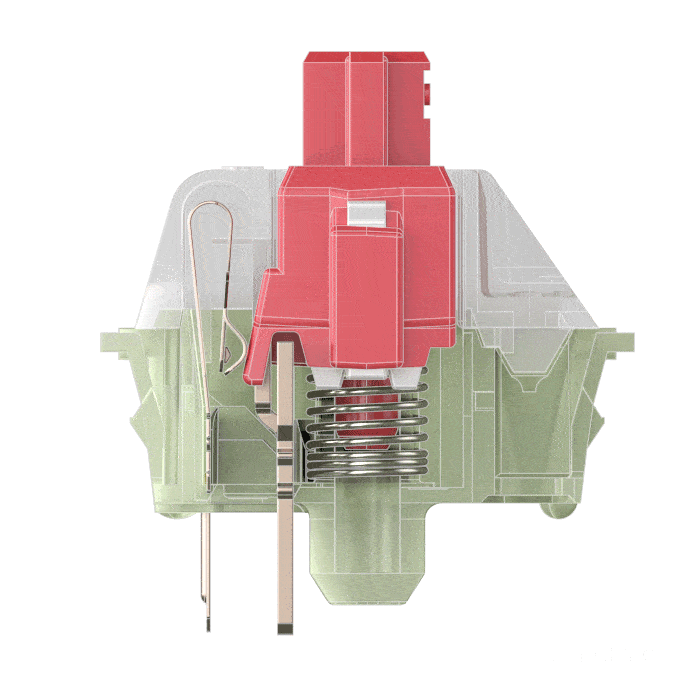
In terms of sound, it’s important to remember that switches are only one part of the equation! Your keyboard’s case, keycaps, etc, will also contribute to how loud your keyboard is!
Lubing and foam-modding your keyboard are two popular ways to soften the sound (and feel) of almost any keyboard.
Low-profile switches:
These switches are, as the name suggests, low-profile. I.e. “shorter.”
They’re essentially a more “compressed down” version of standard MX-style switches, and they’re mainly intended to accompany low-profile keyboards!
If you’d like to see our recommendations for the best low-profile mechanical keyboards, click here.
Speed switches:
These are linear switches that have been designed for faster typing and gaming. Basically, they just have a shorter actuation distance (but only by a tiny amount)!
Pro Tip: “speed switches” are mostly just a marketing ploy. Yes, you might technically save a fraction of a millisecond, but it’s generally NOT enough to make an actual impact on your gaming/typing!
Color Switches by Brand, the Full Breakdown:
Here are some of the more popular switch manufacturers:
- Cherry
- Gateron
- Kailh
- Razer
- Logitech
But even with brands, there are loads more!
- Topre switches
- Akko (see my review of the Akko Matcha Green switches here)
- Drop
- Glorious
- Alps
- Tecsee
- etc, etc
Let’s briefly cover some of the more popular switches:
Cherry MX Switches
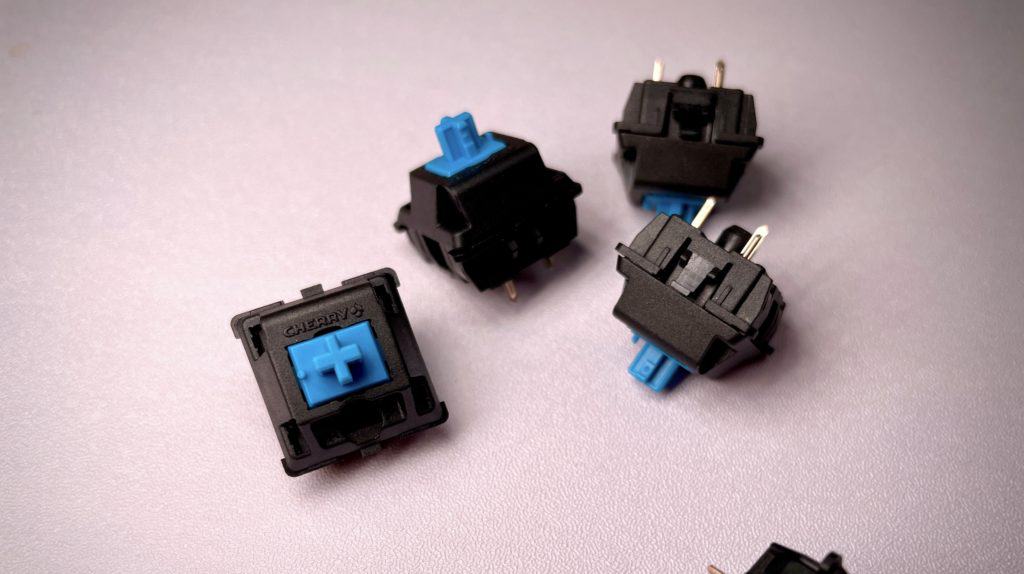
| Switch | Type | Feel | Sound | Recommended for… |
|---|---|---|---|---|
| MX Red | Linear | Light and Smooth | Quiet | Gaming |
| MX Silent Red | Linear | Light and Smooth | VERY quiet | Gaming, or when you need the softest switch possible. |
| MX Black | Linear | Heavy and Smooth | Quiet | Gaming |
| MX Silent Black | Linear | Heavy and Smooth | VERY quiet | Gaming, or when you need the softest switch possible. |
| MX Speed Silver | Linear | Light and Smooth | Quiet | Gaming |
| MX Brown | Tactile | Medium & Tactile | Medium | Gaming & typing |
| MX Clear | Tactile | Heavy & Tactile | Medium | Gaming & typing |
| MX Blue | Clicky | Medium & Tactile | Louder | Gaming & typing & annoying your coworkers |
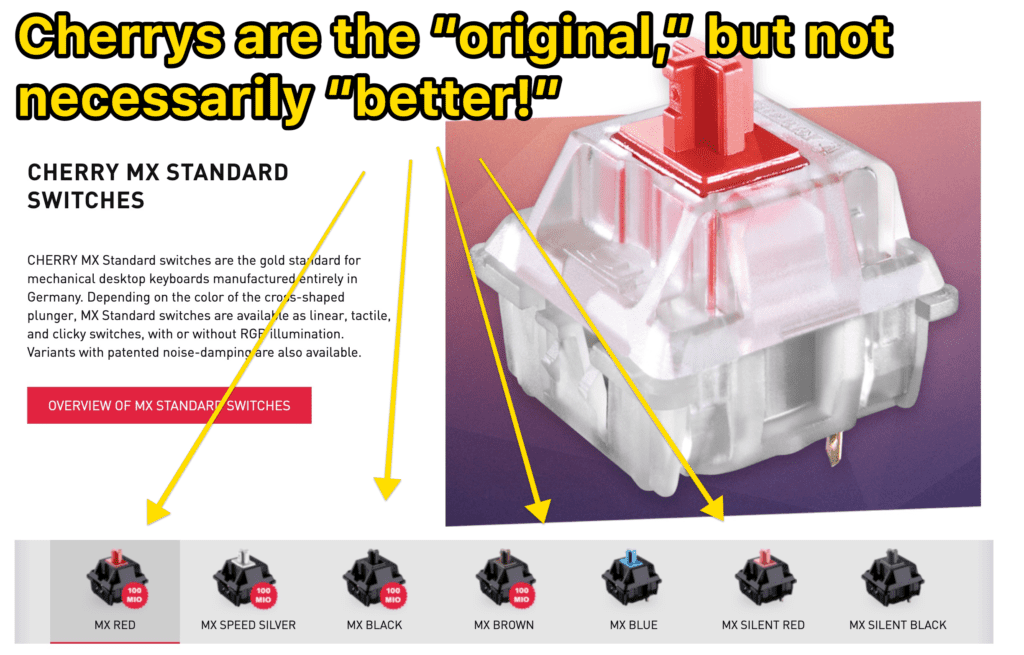
Even though Cherry MX switches are the “gold standard,” it really just means they are the originals!
They do have fantastic consistency, but there are other amazing switches outside of Cherry!
Kailh Switches

Kailh is another great brand of switches, and is generally a bit cheaper than real Cherry switches.
They also make “box” switches, which have a different design than the “MX-style” switches.
They contain little boxes within the bottom housing of the switch, and also have a small box shape at the top of the stem!
The box switches are also waterproof and dustproof.
- Click here to check out our Kailh Box vs Gateron Switch Comparison!
- And here’s our Kailh Box Pink review & sound test (clicky!)
- And our review of the Kailh Box Jades (fave clicky switch ever!)
| Switch | Type | Feel | Sound | Recommended for… |
|---|---|---|---|---|
| Kailh Red | Linear | Light & Smooth | Quiet | Gaming |
| Kailh Black | Linear | Heavy & Smooth | Quiet | Gaming |
| Kailh Brown | Tactile | Medium & Tactile | Medium | Gaming & typing |
| Kailh Box Burnt Orange | Tactile | Heavy & Tactile | Gaming & typing | |
| Kailh Blue | Clicky | Medium & Tactile | Louder | Gaming & typing & annoying your coworkers |
| Kailh Box PInk | Clicky | Light & Tactile | Loud and Crunchy | Gaming, typing, anything! |
| Kailh Box Jades | Clicky | Heavy & crunchy | Loud and Crunchy | Gaming, typing, anything! |
| Kailh Box Navy | Clicky | Heaviest & crunchy | Loud and Crunchy | Gaming, typing, anything! |
There are way more Kailh switches! The “non-box” Kailhs are going to feel similar to Cherry or Gateron switches, but the box switches actually feel a bit different!
Gateron
Gateron switches are another budget brand that are REALLY similar to Cherry MX switches! “Clones,” if you will.
Gateron makes all the normal color switches, but ALSO branches out into further options with…
- Different materials for the plastic housing
- Several different actuation forces to choose from
- and more.
Here are some of Gateron’s switch “lines,” all of which have the normal colors available!
| Type of Gateron Switch | Notes |
|---|---|
| Gateron Inks | They have semi-transparent, inky-looking housing |
| Gateron Pro Switches | Updated molds that reduce stem wobble. More expensive |
| Gateron Box Inks | Same as the inks, but with a small box around the stems |
| Gateron Cap Switches | Similar to Inks, but with a tighter stem and lower pitch |
Specifically, the Gateron Ink Blacks and Gateron Milky Yellows are community favorites!
(they also make “normal” colors that are cheaper. Gateron Brown, Gateron Red, Gateron Blue, etc)
Razer Switches
Razer is a massive name in the gaming industry, making everything from gaming mice, eGPUs, and mechanical keyboards!
These keyboards often include their proprietary Razer switches.
- Razer Green – heavy clicky
- Razer Orange – medium tactile
- Razer Yellow – light linear
The Razer switches are going to feel very similar to Gateron and Kailh switches (in fact, the same company that makes Kailh switches, Kaihua, is also a manufacturer for Razer switches).
Other switch brands – Drop, Topre, Glorious, Alps, Tecsee, and Outemu
There are several more companies that are releasing mechanical switches these days.
I won’t list out every single switch (that’d take forever), but here are some of the top switches from the mechanical keyboard communities:
| Switch | Type | Feel | Notes |
|---|---|---|---|
| NovelKeys Cream | Linear | Medium | “NK Creams” are popular–and therefore rare. |
| Alpacas | Linear | Medium – Heavy | No idea who makes these, but they’re popular |
| Tecsee Carrot | Linear | Medium | Super cheap but good! |
| Zeal Tealios V2 | Linear | Medium | Super smooth (supposedly, too expensive for my taste) |
| Drop Invyr Holy Panda | Tactile | Medium | A hugely popular (but expensive) tactile |
| Drop Halo Clear | Tactile | Heavy | Great for typists in general. Also more expensive |
| Drop Halo True | Tactile | Medium | |
| Glorious Panda | Tactile | Medium | A cheaper clone of the HOLY pandas! |
How to Improve the Look and Feel of Mechanical Keyboard Switches
You can improve the look and feel of any mechanical keyboard switch, regardless of its color or type. Here are a few popular methods:
Lubing Your Switches
This is a simple way to make your keyboard feel smoother (and sometimes quieter).
The process usually involves:
- Removing your keycaps
- Removing your switches (on a hot-swappable keyboard, you’ll simply pull them out. If your keyboard is NOT hot-swappable, you’ll need to take apart the entire keyboard and desolder the switches. It’s a pain!)
- Take apart each switch
- Apply a tiny bit of lube to the stem, spring, and optionally the housing
- Reassemble your switch & put them back in
Click here to see our full guide for lubing your keyboard switches!
Filming your switches
“Switch films” are thin pieces of plastic that you place between the upper and lower housing of your switch (like making a sandwich)!
The main issue they fix is “wobble.” I.e. your switch not fitting together very tight and causing a tiny amount of rattle whenever you press it.
Not all switches need filming, but those that DO will see a huge increase in terms of feel and sound!
Here’s a video tutorial on filming your switches:
Mechanical Keyboard Switch F.A.Q.
What color switches are the best?
Everyone’s preferences are different! That said, linear switches (reds, blacks) are usually preferred for gaming, which tactile switches (browns) and clicky switches (blue, green) are more popular for typing or general computer use!
You’ll also want to consider the loudness. If you’re in an office, you might want to avoid clicky switches like blues and greens and instead choose tactile switches like browns.
What do different colored switches mean?
Switch colors usually indicate the type of switch (linear, tactile, or clicky), therefore the way the switch sounds and feels. There are tons of switch colors, but the more popular ones are red (linear switches), brown (tactile switches), and blue (clicky switches).
What is the best color switch for gaming?
This is completely subjective! However, most people tend to prefer linear switches for gaming (like MX Red and MX Black), as they’re less noisy and have a fast actuation force.
See also:
What is the best color switch for typing?
Tactile switches, like MX brown or MX clear, are usually considered the best switches for typing, as they provide a noticeable bump when you reach the actuation point. This helps you to type without looking at your keyboard and helps with accuracy.
